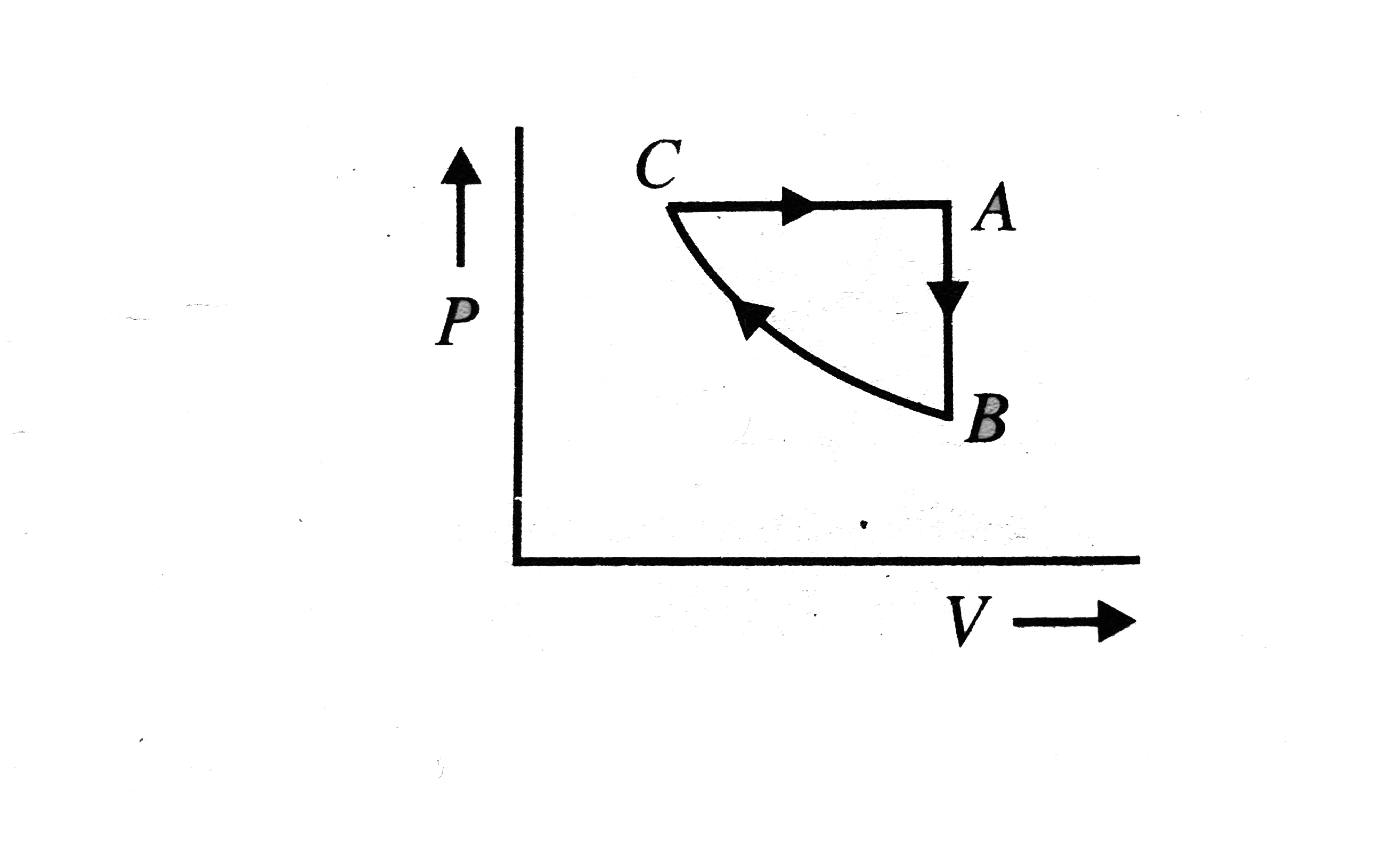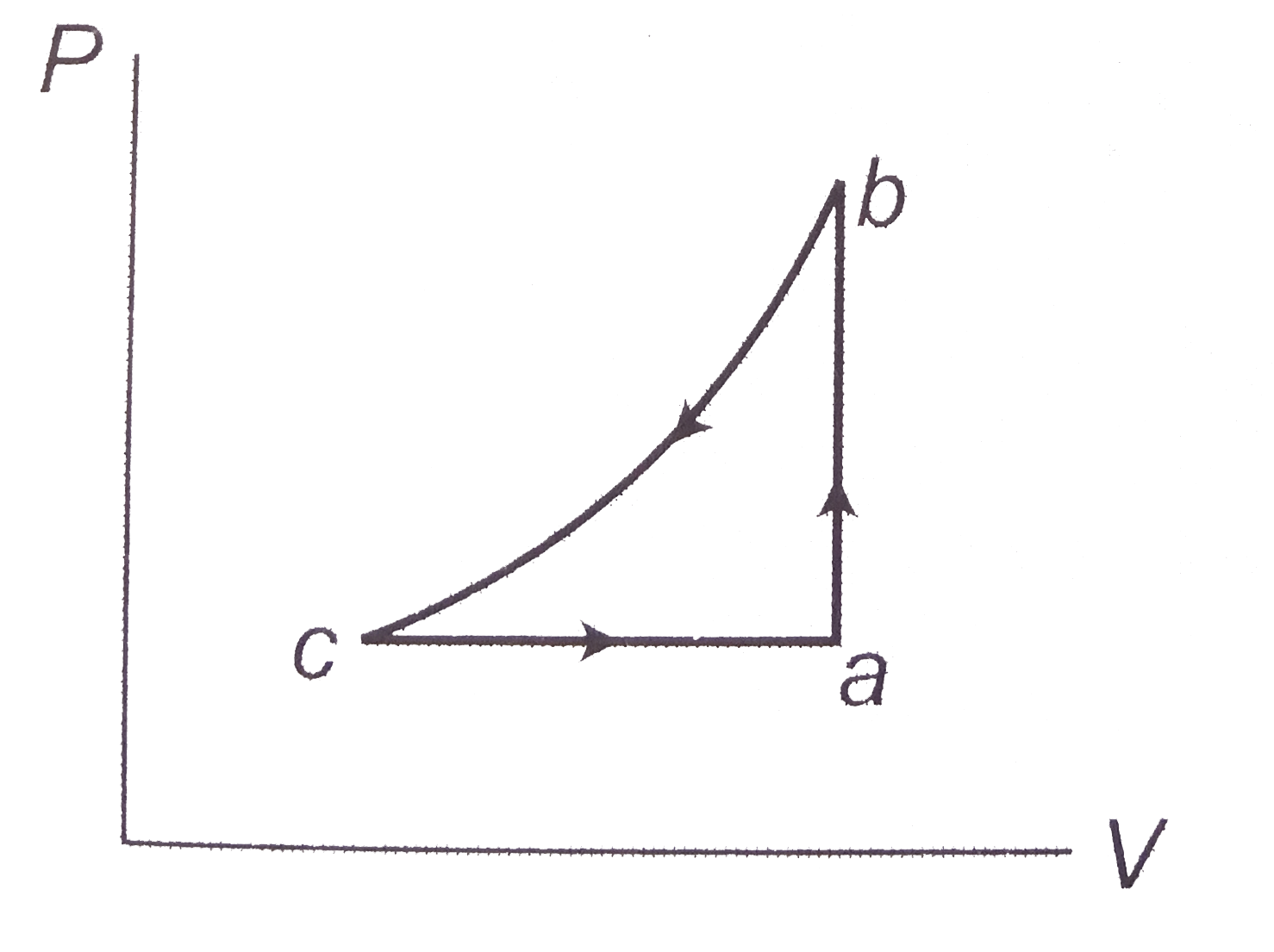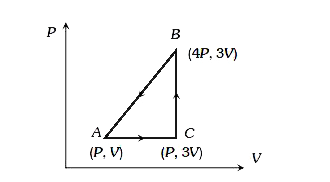A sample of an ideal gas is taken through the cyclic-process ABCA shown in Fig. It rejects 50J of heat during the part AB, doens not absorb or reject the heat during BC, and accepts 70J of heat during CA. Forty joules of works is done on the gas during the part BC. The internla energies at B and C, respectively, will be

1450J and 1410J
1550J and 1590J
1450J and 1490J
1550J and 1510J
The correct Answer is:C
c. Along AB
ΔQ=ΔU+ΔW=UB−UA+ΔW
or −50=UB−UA=−1500
or UB=1450J
Along path BC
or ΔQ=UC−UB+ΔW
or 0=UC−UB+ΔW=UC−UB+(−40)
or 0=UC−1450−40 or UC=1490J
Topper's Solved these Questions
- KINETIC THEORY OF GASES AND FIRST LAW OF THERMODYNAMICSBOOK - CENGAGE PHYSICSCHAPTER - KINETIC THEORY OF GASES AND FIRST LAW OF THERMODYNAMICSEXERCISE - Multiple Corrects
29 Videos
- KINETIC THEORY OF GASES AND FIRST LAW OF THERMODYNAMICSBOOK - CENGAGE PHYSICSCHAPTER - KINETIC THEORY OF GASES AND FIRST LAW OF THERMODYNAMICSEXERCISE - Assertion-Reasoning
6 Videos
- KINETIC THEORY OF GASES AND FIRST LAW OF THERMODYNAMICSBOOK - CENGAGE PHYSICSCHAPTER - KINETIC THEORY OF GASES AND FIRST LAW OF THERMODYNAMICSEXERCISE - Subjective
22 Videos
- KINETIC THEORY OF GASESBOOK - CENGAGE PHYSICSCHAPTER - KINETIC THEORY OF GASESEXERCISE - Compression
2 Videos
- LINEAR AND ANGULAR SIMPLE HARMONIC MOTIONBOOK - CENGAGE PHYSICSCHAPTER - LINEAR AND ANGULAR SIMPLE HARMONIC MOTIONEXERCISE - Multiple Correct Answer Type
9 Videos
Similar Questions
A sample of an ideal gas is taken through the cyclic process abca . It absorbs 50 J of heat during the part ab, no heat during bc and rejects 70 J of heat during ca. 40 J of work is done on the gas during the part bc.(a) find the internal energy of the gas at b and c if it is 1500 J at a. (b) calculate the work done by the gas during the part ca.

View Solution
A sample of an ideal gas in taken through the cyclic process abca in the given figure. It absorbs 50 J of heat during the parth ab, no heat during bc and rejects 70J of heat during ca, 40 J of work is done on the gas during the part bc.
(a) Find the internal energy of the gas at b adn c if it is 1500 J at a. ltbr> (b) Calculate the work done by the gas during the part ca.
View Solution
Knowledge Check
A sample of an ideal monoatomic gas is taken round the cycle ABCA as shown in the figure the work done during the cycle is
 AZeroB3PVC6PVD9PV
AZeroB3PVC6PVD9PVA sample of ideal monoatomic gas is taken round the cycle ABCA as shown in the figure. The work done during the cycle is
 A3 pVBzeroC9 pVD6 pV
A3 pVBzeroC9 pVD6 pVA thermodynamic system is taken through the cycle ABCD as shown in figure. Heat rejected by the gas during the cycle is
 A2PVB4PVC12PVDPV
A2PVB4PVC12PVDPV
A gas is taken through a cyclic process ABCA as shown in, if 2.4 cal of heat is given in the process, what is the value of J ?

View SolutionAn ideal gas is taken around the cycle ABCA shown in P−V diagram. The net work done by the gas during the cycle is equal to

View SolutionA thermodynamic system is taken through the cycle ABCD as shown in the figure. Heat rejected by the gas during the cycle is

View SolutionAn ideal gas is taken around the cycle ABCA as shown in P-V diagram. The net work done by the gas during the cycle is equal to :

View SolutionAn ideal gas is taken around the cycle ABCA as shown in P−V diagram. The net work done by the gas during the cycle is equal to:
View Solution
